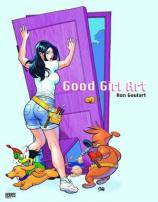Good Girl Art
Review
Good Girl Art
When it comes to comic art, the phrase “good girl” doesn’t refer to the personality of the females depicted, just the attractiveness of the girls being drawn: “This art of girls is good.” With origins in the Golden Age of comics and pulp magazines, “good girl” artwork can still be seen in just about every mainstream comic you pick up, and Good Girl Art from Hermes Press explores this creative phenomena articulately, with plenty of examples. Of course, you’re here for the pictures, and there are many.
Good Girl Art refers to many different examples of females in comic artwork, from the 1930s until the present, and discusses the creation of characters from Sheena to Supergirl, and from Vampirella to Batgirl. Arguably just about every female depicted in comics is, to some degree, “good girl art,” since idealizations of the human form (both male and female) dominate the genre, but Good Girl Art focuses on the very specific aesthetic of women depicted in sexualized contexts: tight costumes, bare midriffs, a shoulder strap sliding off in the middle of a kidnapping attempt.
Author Ron Goulart expertly describes these distinctions in the text throughout the book, which explores the connections and evolutions of the genre as it advanced, including many forgotten characters along the way. It serves as a great exploration of comic history, including oft-forgotten female artists and the effects of the Comics Code Authority and Fredric Wertham on comic books in general.
Good Girl Art is also a good reminder that art of attractive females isn’t necessarily misogynistic, but has served to empower women as well. Whenever there’s a crusade against comics, one of the first things usually attacked is the depiction of females within the pages, but Good Girl Art reminds us that perception is everything. It’s also wise to remember that every heroic male character is also an idealized form. Objectification, as Goulart implies throughout, is not always the intent.
Any one of these artists has (or deserves) books dedicated to their beautiful artwork: Brian Bolland, Dave Stevens, Frank Cho, Adam Hughes, Bruce Timm, Howard Chaykin, and the wealth of other artists included here. Every page is full of perfectly reproduced images, if not completely covered with pictures of pretty girls. As an oversized book, that leaves plenty of space for pretty. Only the last handful of pages are dedicated to modern “good girl” art, with a majority of the book exploring the period between 1930 and 1960, and almost exclusively staying within the United States. There are lots of other artists who could have been included here, like Sam Keith, Phil Noto, and even Milo Manara’s tamer work, but the selection here is more than fair.
It probably goes without saying that the book has plenty of suggestive material, but the very nature of “good girl” art prevents any of it from being expressly vulgar. It’s a kind of innocence that’s broken by two examples of actual nudity, marking this as a book that is best suited for mature audiences and people interested in the mechanics of comic book history. It’s an inspiring look at one very specific element that exists at the core of the comic industry, and it’s worth checking out—even if you just like looking at pretty girls.
Reviewed by Collin David on February 12, 2008
Good Girl Art
- Publication Date: February 12, 2008
- Genres: Graphic Novel
- Hardcover: 224 pages
- Publisher: Hermes Press
- ISBN-10: 1932563873
- ISBN-13: 9781932563870



